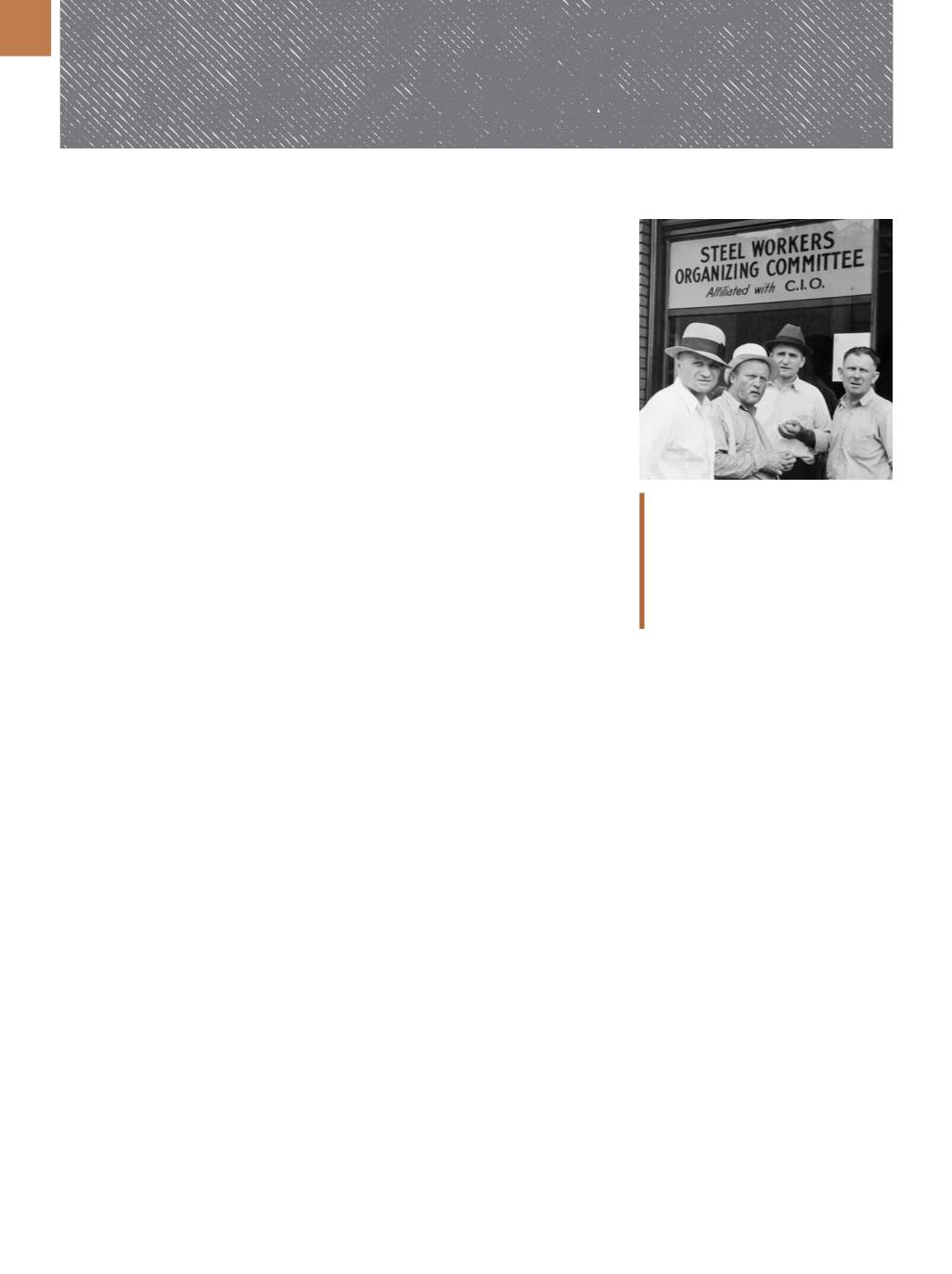

A D V A N C E D M A T E R I A L S & P R O C E S S E S | S E P T E M B E R 2 0 1 6
3 0
METALLURGY LANE
Metallurgy Lane, authored by ASM life member Charles R. Simcoe, is a continuing series dedicated to the early history of the U.S.
metals and materials industries along with key milestones and developments.
THE INTEGRATED STEEL INDUSTRY—PART III
THE ADVENT OF “LITTLE STEEL” AND THE STRIKE OF 1937 HAD
A LASTING IMPACT ON THE DOMESTIC STEEL INDUSTRY
AND LABOR RELATIONS IN PARTICULAR.
S
teel companies that emerged in
the Midwest to serve the grow-
ing manufacturing markets in
Ohio, Illinois, and Michigan were much
smaller than United States Steel Corp.
(USS), and therefore referred to as “Lit-
tle Steel.” These companies included
Youngstown Sheet and Tube Co. (YS&T)
in Ohio, Inland Steel Co. in Chicago,
Jones & Laughlin Steel Co. (J&L) in
Pittsburgh, The American Rolling Mill
Co. (ARMCO) in Middletown, Ohio,
Republic Steel Co. in Cleveland, and
National Steel Corp. in Detroit. These six
companies—combined with Bethlehem
Steel who joined them in their crusade
to prevent employees from forming a
union—gained notoriety by displaying
the worst reaction to organized labor
in the history of American steelmaking.
Labor unrest was common in the
steel industry. Low wages, a hot and
dirty work environment, unsafe con-
ditions, and poor treatment of work-
ers lead to strikes. One serious strike
occurred at YS&T in 1916 where work-
ers were fired on by company guards,
killing two and wounding more than
100. The incident resulted in a riot
that burned down part of the city of
Youngstown. These isolated strikes
were often limited to one company or
one plant and were therefore never suc-
cessful. Steelworkers were unable to
form an organization that would lead to
industry-wide action and there was no
legal basis for workers to join a union
like those that protected corporations.
Therefore, company officials could call
on the police or the National Guard
to break up a strike and protect their
property. This lack of legal protection
for workers was corrected during the
Franklin D. Roosevelt administration.
NATIONAL LABOR
RELATIONS ACT
Congress passed a labor bill writ-
ten by Senator Robert F. Wagner of
New York that became known as the
National Labor Relations Act, signed
by President Roosevelt on July 5, 1935.
The Act gave workers the right to orga-
nize and bargain with management
for wages, hours, and other benefits.
The Act also established a National
Labor Relations Board (NLRB) to over-
see elections and examine company
labor policies. Forty-five years after the
worker struggle at Homestead—where
Henry Frick faced down strikers with
300 armed guards—labor finally had
the backing of the federal government
for the right to form unions to negotiate
with management.
However, the immediate problem
was finding an organization that could
assist steelworkers with organizing a
nationwide union movement. John L.
Lewis, president of the national United
Mine Workers union for coal miners,
formed a Steel Workers Organizing Com-
mittee (SWOC). Using officials from his
own union, he recruited workers from
the steel industry. He selected Philip
Murray to head the activity. The SWOC
demanded a $5 per day, 40-hour work
week, plus time and a half for overtime.
Lewis’s first goal was to organize
the largest steel companies, believing
that the smaller firms would follow.
His breakthrough came in March 1937
when he and Myron Taylor, president of
USS, signed an agreement to recognize
the SWOC for its 225,000 workers. How-
ever, Lewis had misjudged the reac-
tion of the Little Steel companies and
Bethlehem Steel. With regard to Taylor,
Lewis was working with an individual
with a background in law and finance
as well as experience in industries other
than steel. However, with Little Steel
and Bethlehem, Lewis faced two of the
most anti-union men in the history of
steel—Eugene Grace and Tom Girdler.
GRACE AND GIRDLER
Eugene Grace began work as a
crane operator at Bethlehem in 1898
right out of Lehigh University. Under
Charles Schwab, he advanced to pres-
ident within 16 years. He adopted his
attitude toward labor fromSchwabwho
had been superintendent of the Home-
stead plant during the 1892 strike. From
that event, Schwab formed his extreme
attitude toward unions.
Tom Girdler was another enemy of
the labor unions. He became president
of J&L, but left to take over the newly
formedRepublic Steel Co. in 1930. To pro-
tect their companies during the unrest of
the 1930s, Bethlehem and Republic Steel
Founded in 1936, the Congress of Indus-
trial Organizations (CIO) achieved victory
when it forced the “Little Steel” compa-
nies to finally recognize the Steel Workers
Organizing Committee as the bargaining
agent for its steelworkers in 1942. Courte-
sy of explorepahistory.com.


















